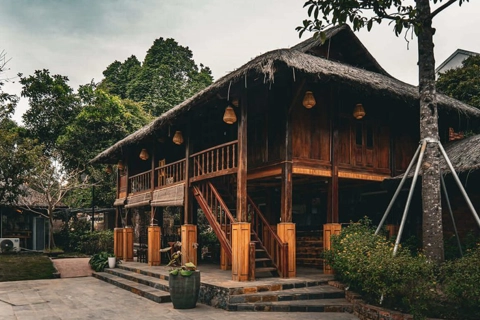Travel
Vietnam discovers 58 new caves in Phong Nha-Ke Bang National Park
Dec 14, 2017 / 02:52 PM
Vietnam has uncovered 58 new caves and grottos in Phong Nha - Ke Bang National Park, a UNESCO world heritage site in Vietnam`s central Quang Binh province, according to the Phong Nha - Ke Bang National Park Management Board.
Le Thanh Tinh, Director of Phong Nha - Ke Bang National Park Management Board, revealed that the newly-found caves have never been announced before, and are located in the buffer zone communes of Minh Hoa district.
Among the 58 caves, some are big and valuable, the national park announced on Wednesday, noting that many caves might have been used by Vietnamese soldiers in the wartime because the park's staff have found some objects such as cartridge cases there.
Rangers and officials from the national park organized independent surveys, without the participation of the British Cave Research Association (BCRA).
Using the initial recognition method, then comparing cave data that the BCRA experts have identified and then eliminating duplicate caves, the final list of 58 new cave records has been compiled and published for the first time.
Some caves have been surveyed by the staff of Phong Nha - Ke Bang Park, but most have not been explored yet due to limited technical conditions.
According to Tinh, the profiles of the 58 caves will be transferred to the BCRA to continue surveying in the near future and details will be published when the survey team has discovered the size of each cave.
Phong Nha-Ke Bang National Park is located in the middle of the Annamite Mountain Range in Vietnam’s Quang Binh province and shares its boundary with the Hin Namno Nature Reserve in the Lao PDR to the west. The property comprises an area of 123,326 ha and contains terrestrial and aquatic habitats, primary and secondary forest, sites of natural regeneration, tropical dense forests and savanna and is rich in large, often spectacular and scientifically significant caves.
The property contains and protects over 104 km of caves and underground rivers making it one of the most outstanding limestone karst ecosystems in the world. The karst formation has evolved since the Palaeozoic period (some 400 million years ago) and as such is the oldest major karst area in Asia. Subject to massive tectonic changes, the karst landscape is extremely complex, comprising a series of rock types that are interbedded in complex ways and with many geomorphic features. The karst landscape is not only complex but also ancient, with high geodiversity and geomorphic features of considerable significance.
The karst formation process has led to the creation of not only underground rivers but also a variety of cave types including: dry caves, terraced caves, suspended caves, dendritic caves and intersecting caves. With a length of over 44.5 km the Phong Nha cave is the most famous of the system with tour boats able to penetrate inside to a distance of 1,500 m. The Son Doong Cave, first explored in 2009, is believed to contain the world’s largest cave passage in terms of diameter and continuity.
A large number of faunal and floral species occur within the property with over 800 vertebrate species recorded comprising 154 mammals, 117 reptiles, 58 amphibians, 314 birds and 170 fish. The property clearly has impressive levels of biodiversity within its intact forest cover, notwithstanding some gaps in knowledge of the population status of some species.
Among the 58 caves, some are big and valuable, the national park announced on Wednesday, noting that many caves might have been used by Vietnamese soldiers in the wartime because the park's staff have found some objects such as cartridge cases there.

Son Doong of Phong Nha-Ke Bang National Park is the world’s largest cave.
|
Rangers and officials from the national park organized independent surveys, without the participation of the British Cave Research Association (BCRA).
Using the initial recognition method, then comparing cave data that the BCRA experts have identified and then eliminating duplicate caves, the final list of 58 new cave records has been compiled and published for the first time.
Some caves have been surveyed by the staff of Phong Nha - Ke Bang Park, but most have not been explored yet due to limited technical conditions.
According to Tinh, the profiles of the 58 caves will be transferred to the BCRA to continue surveying in the near future and details will be published when the survey team has discovered the size of each cave.
Phong Nha-Ke Bang National Park is located in the middle of the Annamite Mountain Range in Vietnam’s Quang Binh province and shares its boundary with the Hin Namno Nature Reserve in the Lao PDR to the west. The property comprises an area of 123,326 ha and contains terrestrial and aquatic habitats, primary and secondary forest, sites of natural regeneration, tropical dense forests and savanna and is rich in large, often spectacular and scientifically significant caves.
The property contains and protects over 104 km of caves and underground rivers making it one of the most outstanding limestone karst ecosystems in the world. The karst formation has evolved since the Palaeozoic period (some 400 million years ago) and as such is the oldest major karst area in Asia. Subject to massive tectonic changes, the karst landscape is extremely complex, comprising a series of rock types that are interbedded in complex ways and with many geomorphic features. The karst landscape is not only complex but also ancient, with high geodiversity and geomorphic features of considerable significance.
The karst formation process has led to the creation of not only underground rivers but also a variety of cave types including: dry caves, terraced caves, suspended caves, dendritic caves and intersecting caves. With a length of over 44.5 km the Phong Nha cave is the most famous of the system with tour boats able to penetrate inside to a distance of 1,500 m. The Son Doong Cave, first explored in 2009, is believed to contain the world’s largest cave passage in terms of diameter and continuity.
A large number of faunal and floral species occur within the property with over 800 vertebrate species recorded comprising 154 mammals, 117 reptiles, 58 amphibians, 314 birds and 170 fish. The property clearly has impressive levels of biodiversity within its intact forest cover, notwithstanding some gaps in knowledge of the population status of some species.








